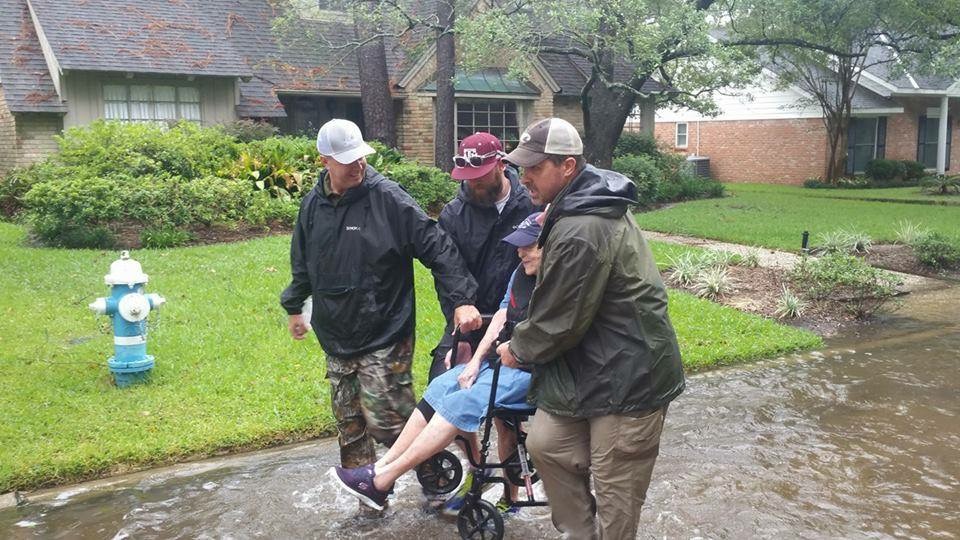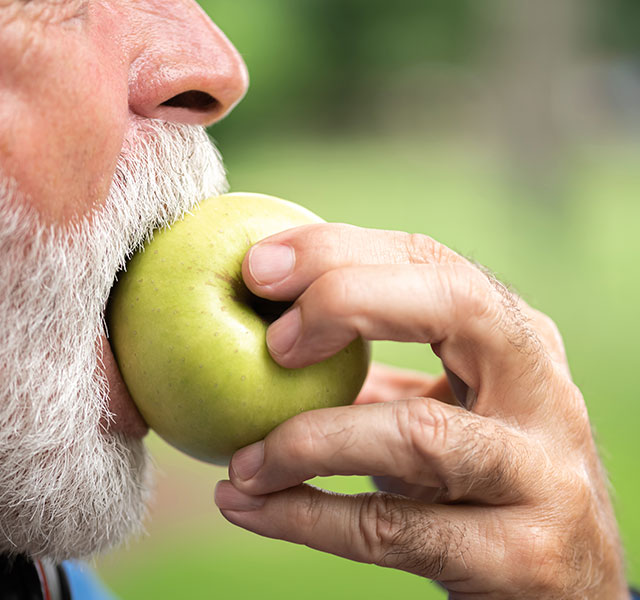When Hurricane Harvey struck his neighborhood on August 28, 2017, the Rev. John Stephens of Chapelwood United Methodist Church in Houston helped launch a “boat ministry.” He and several men in the church navigated privately owned boats into the rising flood waters to rescue neighbors stranded in their homes.
Stephens quickly noticed something victims had in common: most were older people.
“Maybe they were thinking, ‘I’ve seen Hurricane Allison, I’ve seen Rita, I’ve seen Ike,’ and thought they could weather the storm in their homes,” he said.
Maybe. But what Stephens discovered is something emergency-management experts already know—and struggle with: when disaster strikes, older adults are particularly vulnerable.
Almost three-quarters of the 739 people who died in Chicago’s deadly heat wave of 1995 were 65 or older, according to Eric Klinenberg, author of Heat Wave: A Social Autopsy of Disaster in Chicago (2002). Similarly, when Hurricane Katrina struck New Orleans in 2005, three-quarters of those who died were over 60, according to a Knight Ridder analysis, and among those, about half were over 75.
“The victims of Katrina were not disproportionately poor; they were disproportionately old,” wrote Amanda Ripley, author of The Unthinkable: Who Survives When Disaster Strikes—and Why (2008).
The key to surviving a disaster is clear thinking, ahead of time when possible, and during the event itself—making a plan will greatly improve your chance of survival. It’s also important to understand why older adults are more vulnerable, so family, neighbors and communities can help reduce complications and casualties as much as possible.
Planning to Survive
Not all disasters are predictable; forecasters can predict a hurricane, communities can know they are in tornado alleys, yet many emergencies are sudden—earthquakes, transportation accidents, an active shooter. Many people watch these events unfold elsewhere on the news and feel helpless, thinking that there’s no way to prepare. However, surprisingly simple measures—in advance, during and after the emergency—can mean the difference between life and death in an emergency, especially for older adults.
“Even a minor amount of preparation can pay major dividends,” wrote Russel L. Honoré in Survival: How Being Prepared Can Keep You and Your Family Safe (2010). Honoré, a retired US Army lieutenant general, led planning and response operations following several hurricanes, including Katrina.
The American Red Cross’s publication, Disaster Preparedness for Seniors by Seniors, offers three steps for preparedness: get a kit; make a plan; be informed.
Assemble a disaster kit for sheltering at home. The kit should contain enough food, water, medication and medical supplies (hearing aids, glasses, etc.) to last at least three days. Plan on at least one gallon of water per person per day. Include food items that are nonperishable and that don’t require cooking, such as peanut butter, granola bars and canned tuna, meats or beans. (Be sure to store a can opener in your kit, and replenish food periodically to ensure your supply is fresh.)
A flashlight and weather radio are also recommended. Stock extra batteries or buy hand-cranked models. Store vital records and documents (including passports, driver’s licenses, birth and marriage certificates and social security cards) in a fireproof, waterproof container, and make sure it is accessible to grab in an immediate evacuation.
Know how to turn off gas and electric utilities in your home. Keep your car’s gas tank at least half full at all times.
Discuss an emergency plan with family members, or with friends, neighbors, church acquaintances—people who will know to check on you as soon as possible. Decide where you’ll shelter in your home in severe weather, and where you might go if evacuated for an anticipated disaster such as a hurricane. Make a plan for how you’ll stay in touch with family members if you’re separated. Know how to turn off utilities (gas, electricity) in your home. Review your plan every six months and update as needed. Be sure to include out-of-town relatives in your planning and discuss how you’ll let them know your whereabouts should you evacuate.
Power outages after a disaster may drag on for days, even weeks, making it difficult to replenish basic supplies such as gasoline or medication. Keep your gas tank at least half full at all times. If possible, work with your pharmacist and insurance company to obtain a seven-day, emergency supply of all medications. Store them in a waterproof container and rotate them through your medication schedule to keep them fresh. Keep a supply of cash on hand too—ATMs and credit card machines often don’t work if the power is out.
Be prepared to communicate. During Hurricane Harvey, many people called for help with their cell phones, via 911 or social media. Keep your cell phone charged and protected from the elements. Consider investing in a protective case (like an OtterBox) and extra batteries, or a hand-cranked or solar charger. Write down important phone numbers because when your cell battery dies, you won’t be able to access your contacts. Learn steps to minimize power consumption on your cell phone—such as dimming the background light or selecting low-power mode—to extend battery life.
After an emergency, cell service is often overloaded but texting may still work when the network is busy. Don’t forget to try your landline, if you have one, as it may work when cell service is out or slow. Discuss your plans for communication with out-of-town relatives as well as immediate family members.
Finally, stay informed through reliable media sources and community notifications.
Pets and Valuables
If you have a pet, the family disaster kit should include enough food, medicine and water for each animal for at least three days. Prepare to evacuate your animals too.
“If it’s not safe for you to stay behind, then it’s not safe to leave pets behind either,” according to the Red Cross’ online pet-preparation guide. Ready leash or carrier, copies of medical records and any special, care instructions (in a waterproof container or bag), as well as current photos of your pets if you have them, in case an animal gets lost. Ensure that your pet’s vaccinations are up to date. Consider having it microchipped by your veterinarian, which may help you find it should you become separated.
Most American Red Cross shelters do not accept pets, although they do accept service animals. You’ll need to make alternate arrangements to shelter your pet. Find out which hotels along your evacuation route will accept animals. Some will waive no-pet policies in an emergency but call first to confirm. Make a list, with phone numbers, of friends, relatives, boarding facilities, animal shelters or veterinarians that might care for your animals in an emergency.
The ASPCA recommends placing a rescue alert sticker near the front door of your home to notify emergency personnel of animals in the house. Some fire departments provide these. If you do leave with your pets, write “evacuated” on the sticker, so responders don’t waste time looking for them.
In an emergency, your first priority is to keep family members safe. But if time permits, consider moving valuables to safer locations. If you’re anticipating flooding, for example, family photos might be stored upstairs or on a high shelf in a sealed, plastic, storage container. High-value items like jewelry may be moved to a safe or other secure storage.
But Why Are Older People So at Risk?
If you’re concerned about helping an older adult, it helps to understand why they are so vulnerable in disasters.
If an older person has problems with mobility, can’t drive, has no access to transportation or becomes easily confused, evacuation can be difficult. Social isolation contributes too, because they might feel as if they have nowhere to go or no one to ask for help.
In Hurricane Katrina, many low-income older adults were hampered by an unlucky quirk of timing, noted Honoré. The hurricane made landfall in southeastern Louisiana on August 29, 2005—a few days before Social Security or disability checks arrived. For some, that meant there was no money to buy a tank of gas, a bus ticket or an extra bag of groceries.
“When a hurricane hits at the end of the month, the poor, elderly and disabled people who rely on government checks will not have the money to evacuate,” Honoré wrote.
Along with the heroes come the exploiters. When older people go into crisis mode, they’re more vulnerable, scared and not quite as wary.
–Liz Loewy
Older adults are not just physically more vulnerable; they’re also more likely to suffer financially in a disaster’s aftermath. An older adult’s home may have been paid off long ago and thus may not be adequately insured. Applying for disaster aid is a complex and often confusing process that may require multiple visits to an agency office. And then there are the fraudsters—bogus repair services, fake charities and identity thieves—who show up in the wake of every disaster, targeting older adults.
“Along with the heroes come the exploiters,” said Liz Loewy, co-founder of EverSafe, an identity protection service, and former chief of the Elder Abuse Unit in the Manhattan district attorney’s office. “Anyone can fall for a scam, but when older people go into crisis mode, they’re more vulnerable, scared and not quite as wary and able to recognize a scam.”
Loewy adds that even those outside of the disaster area may be vulnerable, as fake charities crop up, purporting to help victims, but actually pocketing donations instead.
Preparing for the Unexpected
Sudden disasters can take many forms and occur in many places: an active shooter, a sinking cruise ship, a car accident, a hostage situation, a terrorist attack.
While it’s not possible to anticipate every emergency, some basic habits can help. Being aware of your surroundings will boost your chances of survival in almost any situation. For example, if you enter a public space like a movie theater, make a note of the location of the exits. If you’re on a cruise, attend the safety demonstration, pay attention and take notes if you think you might forget details.
You can’t guarantee your safety, but you can improve your odds. Many assume plane crashes are generally unsurvivable, but among all passengers involved in serious accidents between 1983 and 2000, more than half survived. (Serious accidents are defined by the National Transportation Safety Board as those involving fire, serious injury or substantial aircraft damage.) Survival often depended on simple steps: paying attention to the flight attendants’ safety briefing, noting the location of exits or evacuating the plane quickly, without pausing to grab luggage.
Preparing as a Nation
About 70 people died in Hurricane Harvey; still too many, but far fewer than the more than 1,800 deaths in Hurricane Katrina. The two disasters were different—for one thing, the water rose much faster in Katrina—but the contrast points to some progress in national preparedness to help keep seniors safe.
“We learned a lot of lessons during Katrina,” said Carrie Reyes, director of emergency
management for Plano, TX. “The best way we can help seniors to be more prepared is through education. We need to demystify disaster and make them aware of the tools to help them prepare.”
She notes that emergency managers at local levels have become much more proactive in establishing connections with older adults in their communities. Reyes, for example, frequently visits older-adult living communities and meets with groups to provide education and to involve them in community disaster planning.
After the events of Hurricanes Katrina and Rita, special needs issues—such as limited mobility, medical conditions or cognitive issues, all of which affect many older adults—were fully integrated into all phases of emergency management. (This was part of an amendment to the Robert T. Stafford Disaster Relief and Emergency Assistance Act, which established laws guiding federal natural-disaster assistance for state and local governments.)
“Emergency managers are now tasked by federal legislation to engage our entire community,” Reyes said. “That includes the very young, the very old and those who may have access or functional needs.”
Some communities have developed systems to better track older adults and those with special needs; several counties in Florida, for example, offer vulnerable-population registries. Residents register their name, location and any special needs in the system. In the event of disaster, the registry may be used to help locate registrants during search and rescue operations.
The neighbor, whom they’d never met, said, “My house is dry and I have a second floor. We’d like you to stay until the water recedes.”
— Carrie Reyes
Reyes, who was deployed after Hurricane Harvey to Port Aransas, TX, to assist local emergency managers in rescue and recovery, also thinks that there’s more awareness of older adults’ needs in disasters.
“There was a lot of spontaneous sheltering and neighbors checking on neighbors with Harvey,” she said. Someone with a key to a local school, for example, might open it as a makeshift shelter if the school was located on higher ground.
Reyes’ great uncle and aunt, both in their 80s, live in Houston; when their house began taking on water, a neighbor knocked on their door. “The neighbor, whom they’d never met, said, ‘My house is dry and I have a second floor. We’d like you to stay until the water recedes.’”
Family members and neighbors can help older adults prepare. If you live close by, include them in family or neighborhood disaster planning. Offer to assemble a disaster kit or to purchase supplies for one.
Reach out to older adults in your community who may not have family nearby or other sources of social support. Provide your contact information and check in on them before a known emergency and after an event occurs.
Simply staying in touch with an older-adult neighbor or family member can be crucial. Author Klinenberg believes isolation contributed to the high death rate among seniors in the Chicago heat wave.
“Decades of migration out of Chicago, where the total population decreased by more than a million between 1950 and 1990, and several neighborhoods lost more than half their residents, increased the likelihood that the city’s seniors would be isolated and alone,” he wrote. By contrast, in neighborhoods like Little Village, where social ties were strong and residents enjoyed congregating in public spaces, older adults fared better during the heat wave.
Even after Preparing, Leaving Might Be Best
Sometimes, older adults may resist evacuation, simply because they’ve lived long enough to survive disasters before. Many who died in Hurricane Katrina, for example, were middle aged when Hurricane Camille struck in 1969; having survived, they felt they could manage.
“I think Camille killed more people during Hurricane Katrina than it did in 1969,” said Max Mayfield, former director of the National Hurricane Center. “Experience is not always a good teacher.”
When an older adult doesn’t want to evacuate, Reyes recommends a realistic but respectful conversation.
“Say, ‘Hey, Mom, Dad, if you stay here, it might get bad and I might not be able to come get you for a couple of days; is that what you want?’” she said. “Respect their wishes but make sure both of you understand the outcome of those decisions.”
Bill and Paulette Rogers of Port Aransas, TX, both in their 60s, learned just how bad it can get during Harvey. They decided to ride out the storm at home, even though their grown children begged them to evacuate. When the storm struck, a tree tore through their upstairs bedroom and water began to surge into the house. The couple ended up spending the night in their pick-up truck, with water up to their shoulders, expecting to die.
Thankfully, they survived.
“This is the dumbest thing I’ve ever done,” Bill Rogers later told a reporter.

Freelance writer Mary Jacobs lives in Plano, TX, and covers health and fitness, spirituality, and issues relating to older adults. She writes for the Dallas Morning News, the Senior Voice, Religion News Service and other publications; her work has been honored by the Religion Communicators Council, the Associated Church Press and the American Association of Orthopaedic Surgeons. Visit www.MaryJacobs.com for more.



